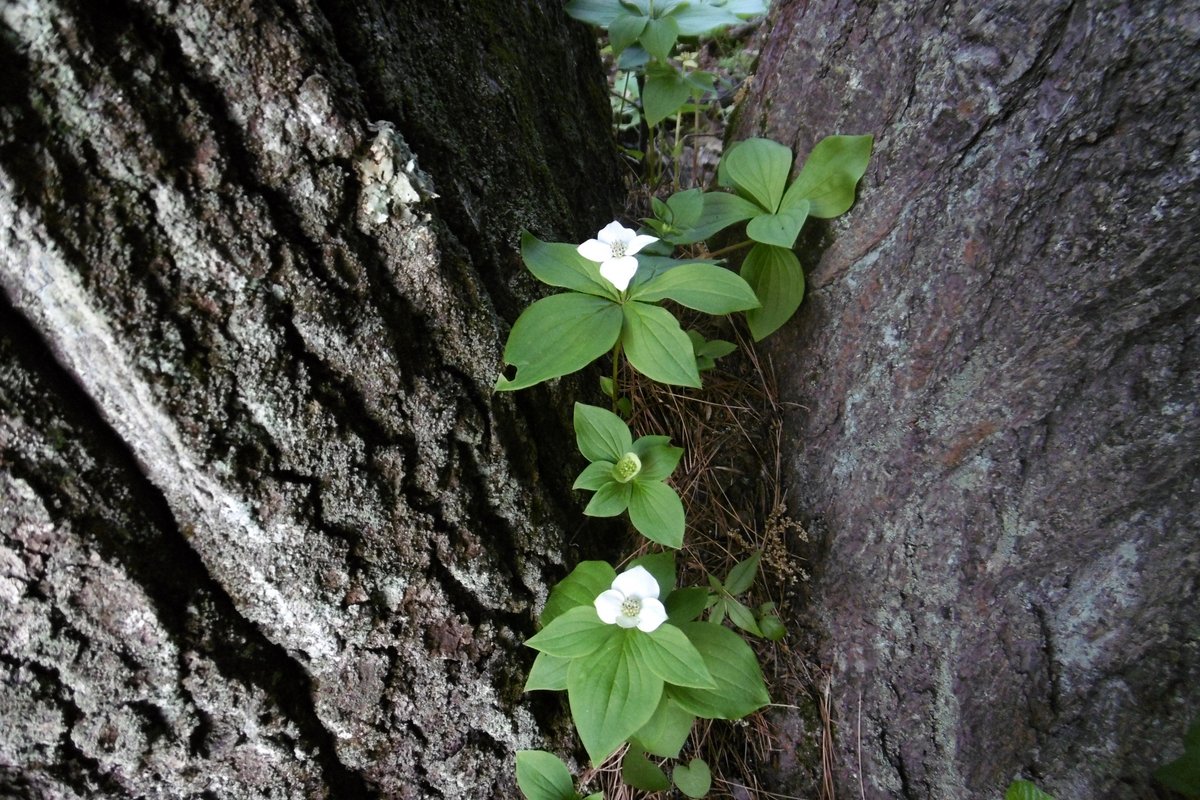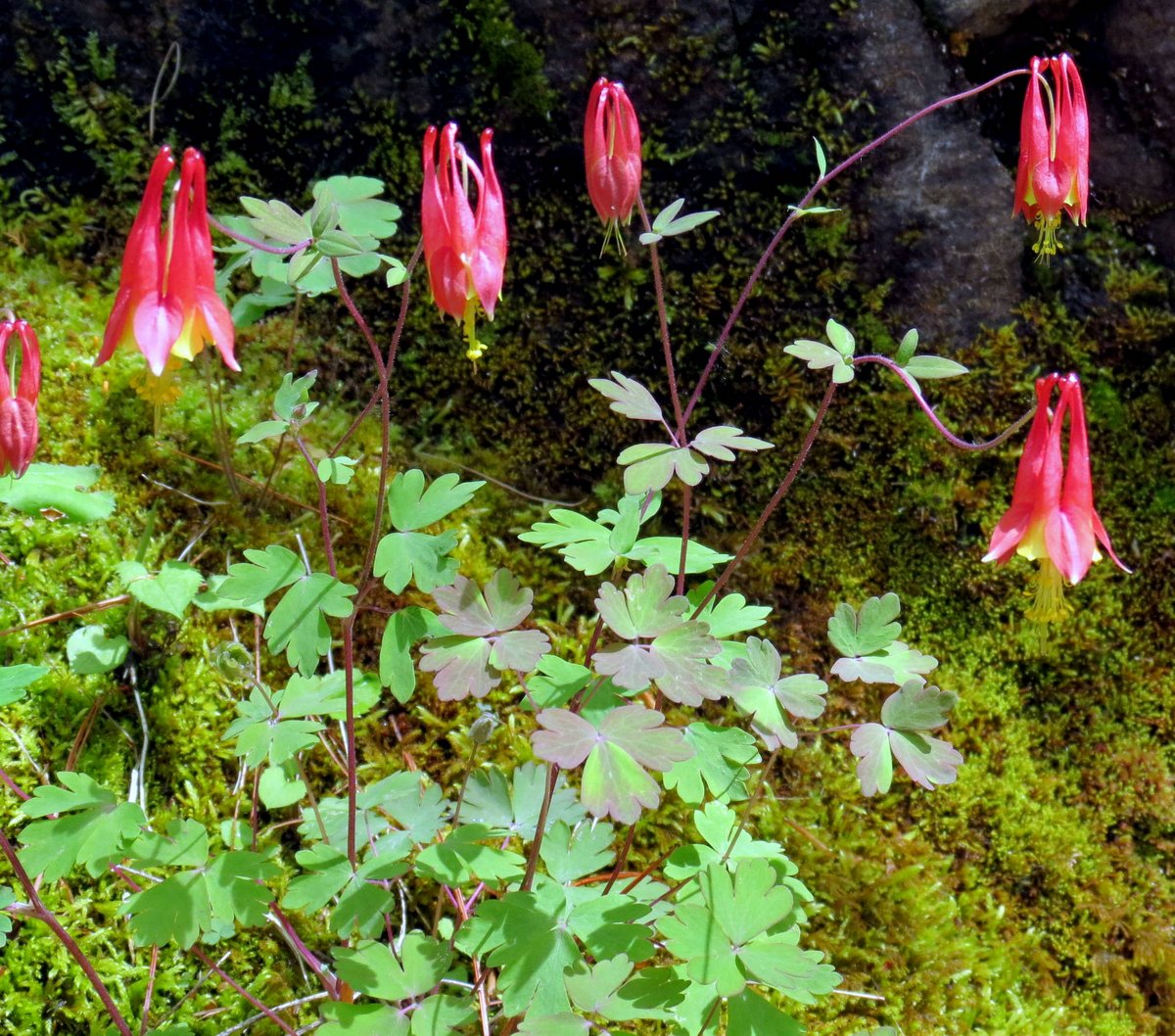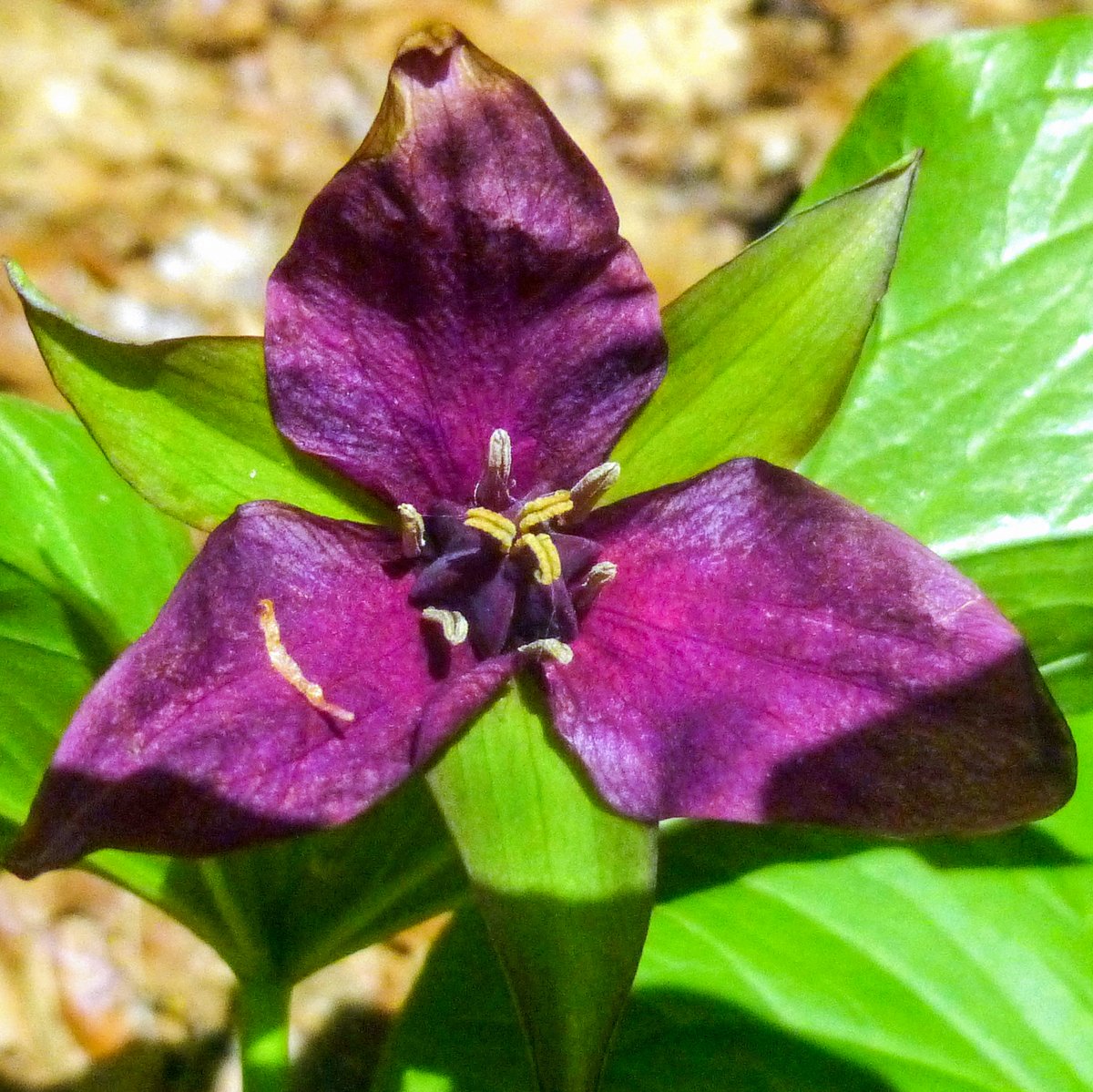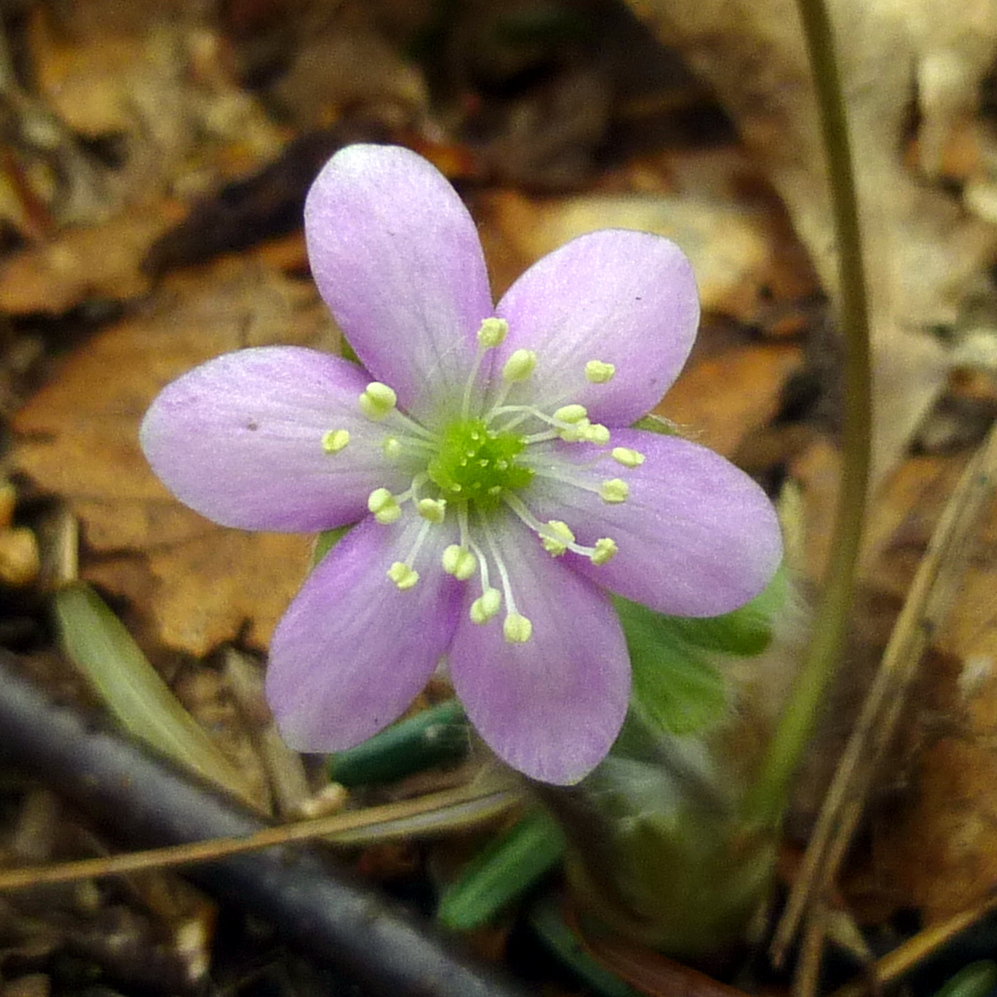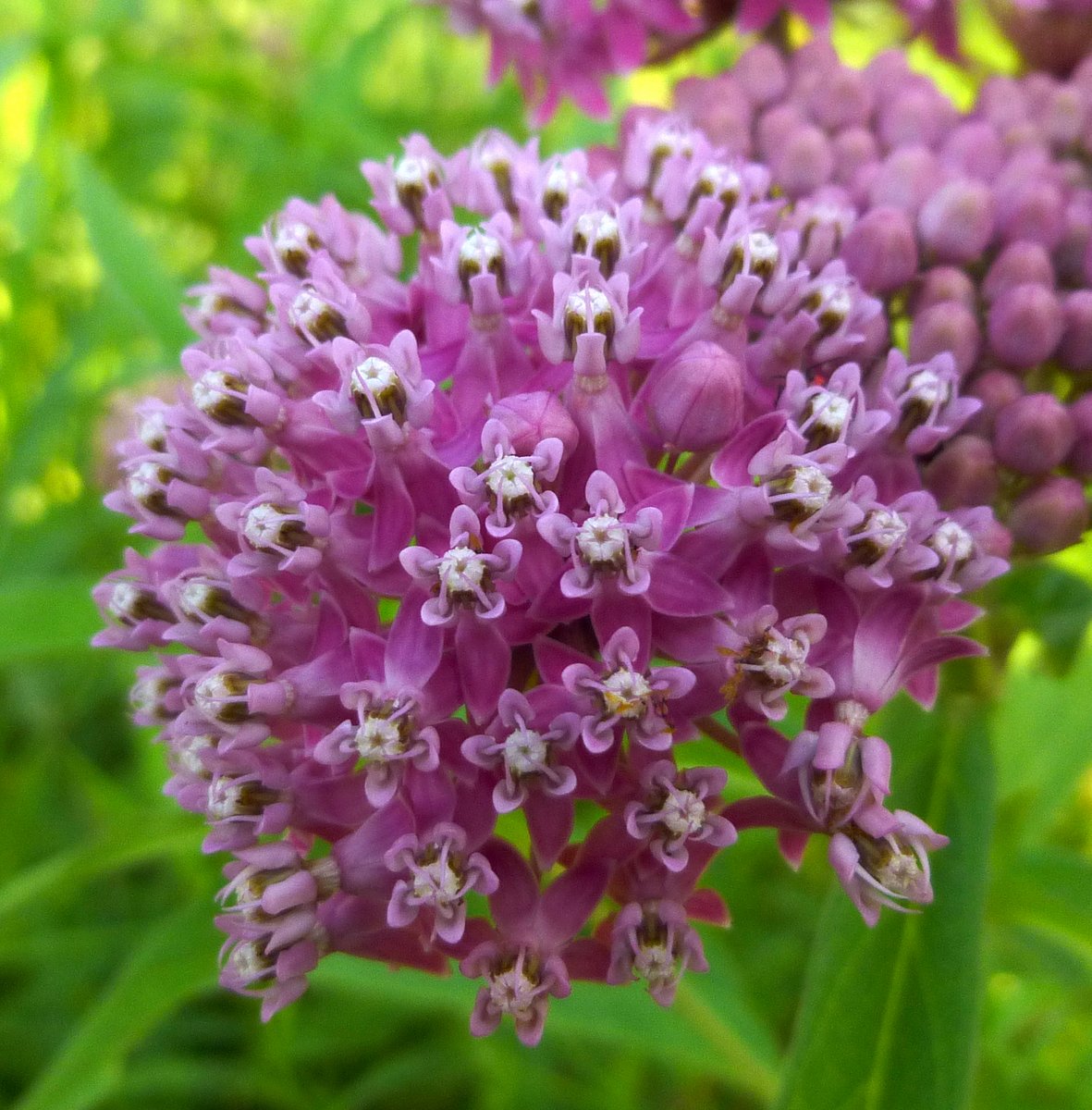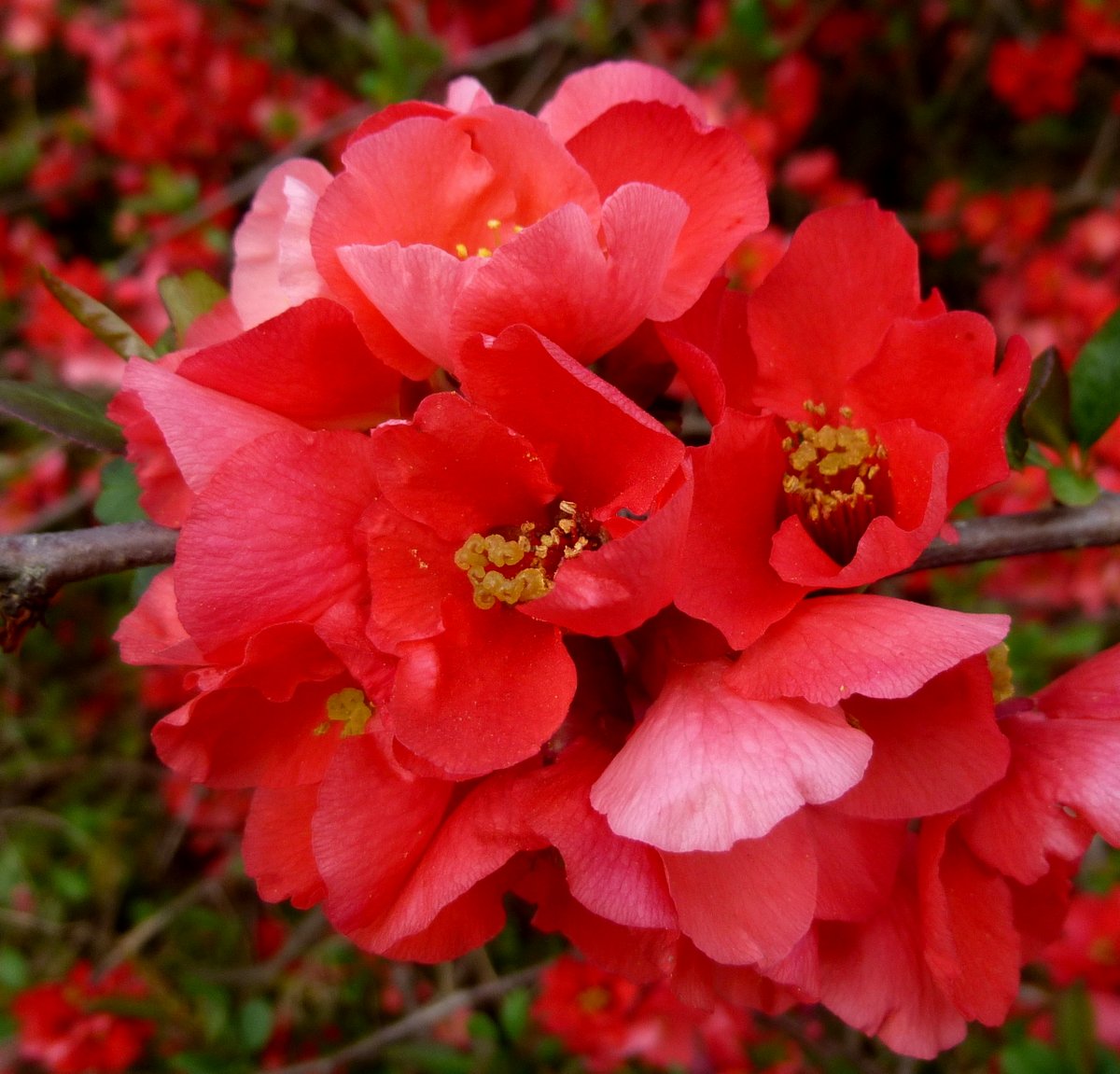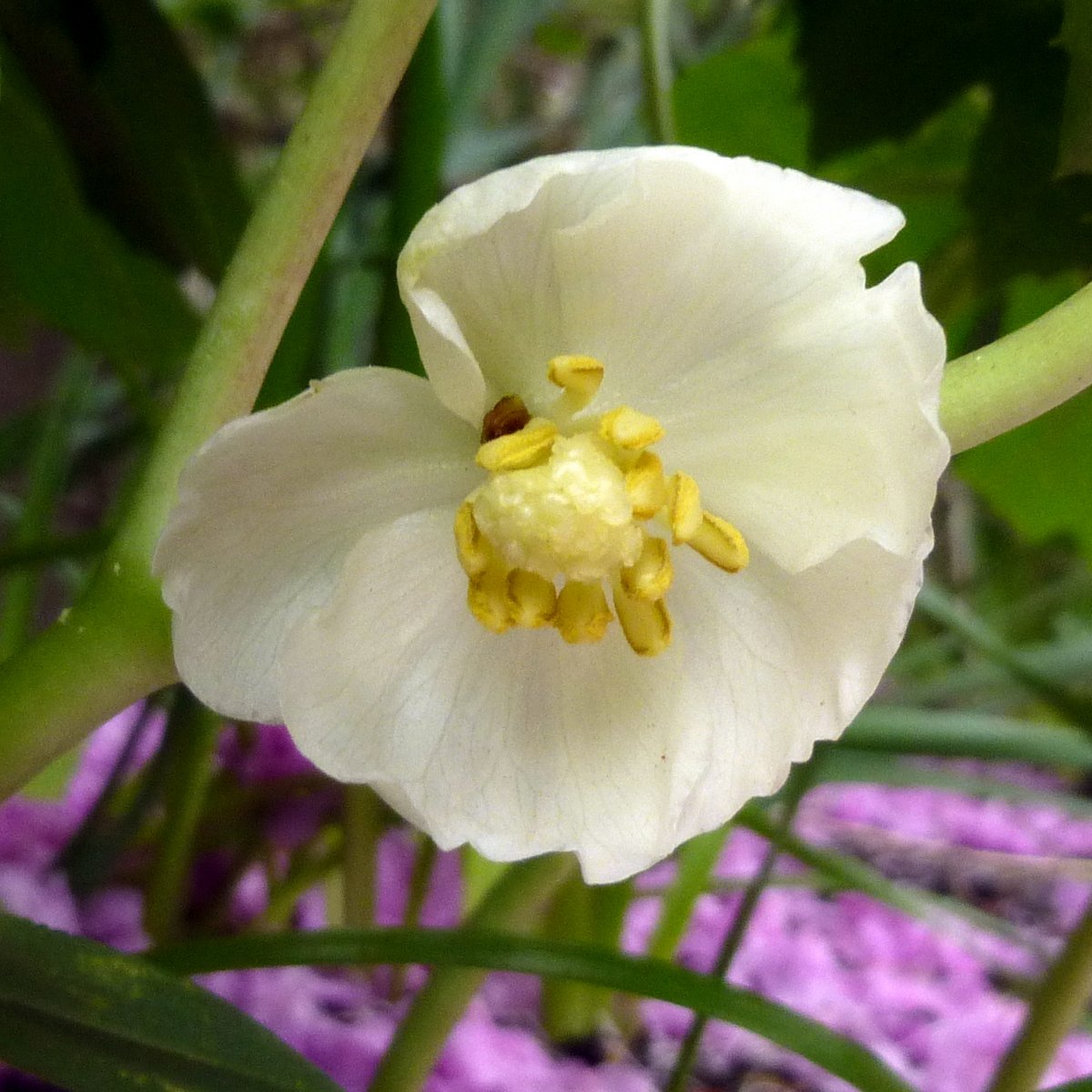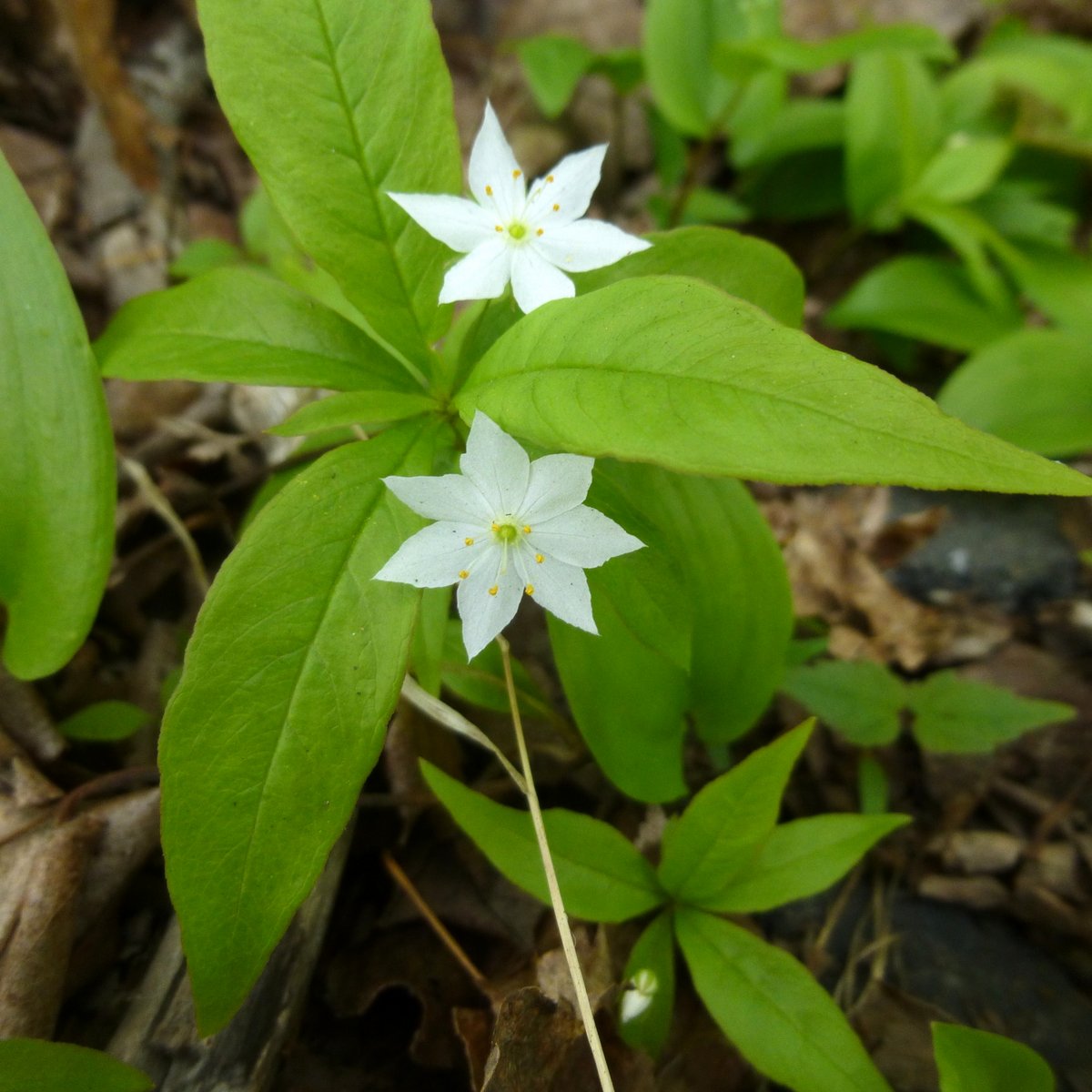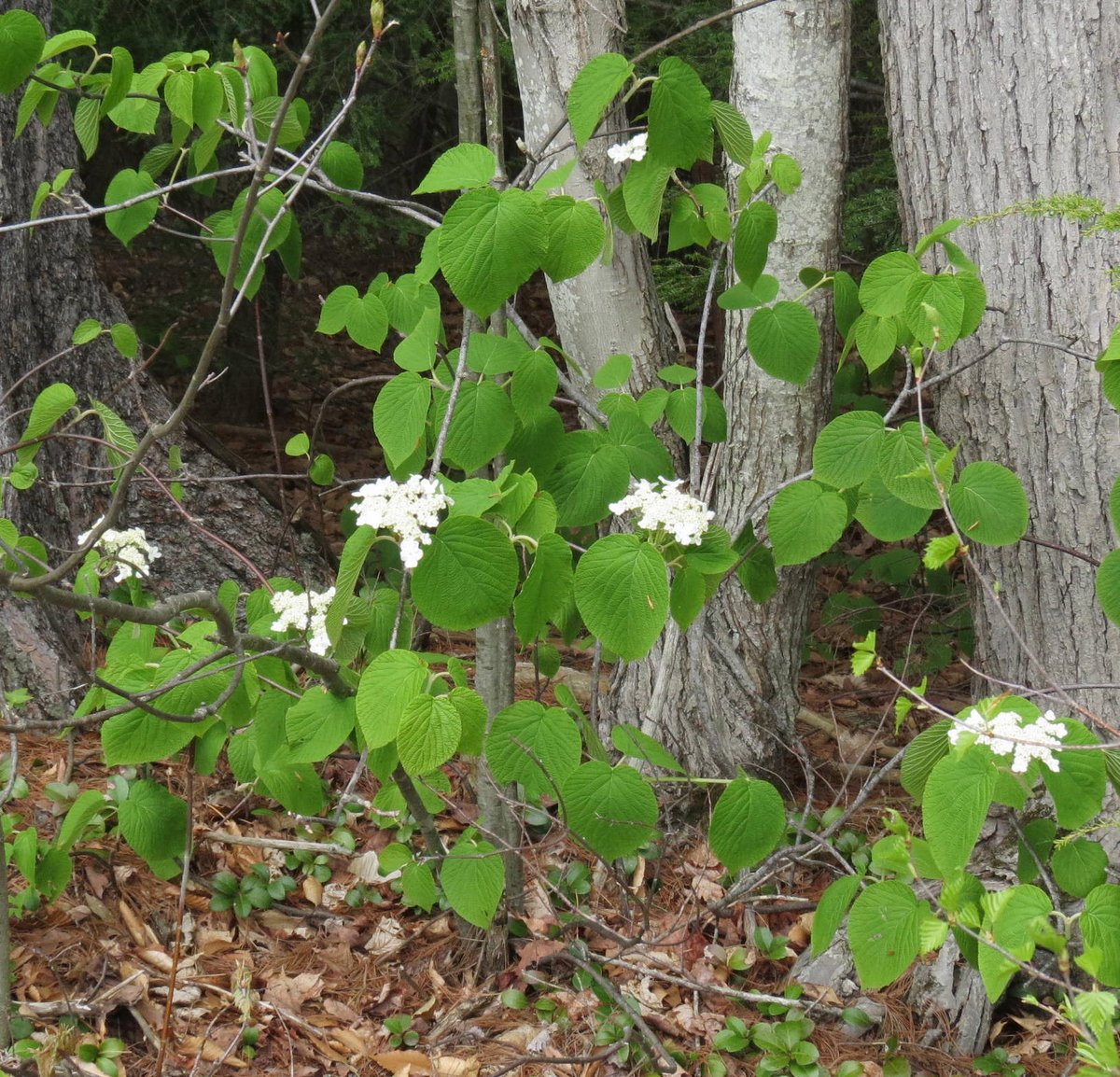
Since trilliums are all about the number 3 or multiples of it, it seems appropriate, I thought for the first time, that I know of only three native trilliums in this area. They are, in order of bloom time, red trillium, nodding trillium, and the beautiful painted trillium seen here. This one surprised me by having a feature I’ve never noticed; dark red anthers frosted with white pollen. My color finding software actually calls the anther color “indian red” and sees the red on the petals as either crimson or deep pink, depending on where I put the pointer. It is those splashes of color on the petals that give this trillium its name and also make it the most beautiful of the three, in my opinion. It’s always a joy to find one because they don’t come easy.

This is a very busy time of year for someone doing a nature blog, because many flowers can appear each day. Apple blossoms have come and gone quickly, and though I haven’t heard anything official yet, I’m wondering if the below freezing nights we had last week might have damaged this year’s apple crop. We had another quite heavy frost just yesterday moning so it looks like nature is going to hold us to our traditional last day of May planting date. You can get tender plants in the ground before then but you’d better be prepared to cover them at night.

The crabapple in my own yard suffered from the 27 degree night we had on the 18th. All its flowers quickly disappeared and that was too bad, because it blossomed better this year than it has in a while. Apple trees aren’t native but crabapples are, so I thought they’d better withstand the cold. Some native and ornamental cherries also had a hard time, and some didn’t blossom at all.

Lilac flowers hadn’t opened yet when we had the freeze and it didn’t look like their buds had been damaged. I caught these just as they started opening two or three days later when temps were back to normal.

White lilacs usually bloom a week or so later than purple ones but this year for some reason they bloomed together. My mother died when I was an infant but before she did she planted white lilacs, so they and a few other flowers she planted always remind me of her.

Lily of the valley flowers on the other hand, always remind me of my grandmother. When I was young I’d run up her stairs with a fist full of violets, dandelions and lily of the valley blossoms, all wilting badly before I could even give them to her. Welch’s Grape Jelly used to come packaged in small glasses that could be re-used as drinking glasses, and she always put the flowers in one of those. She had a few of those glasses that I remember, all with Flinstones characters on them.

When Mayflowers grow naturally they can form large colonies. Their large, umbrella like leaves touch and overlap between the two foot tall plants so they create their own shade underneath. This makes getting a shot of the flower tricky. You have to open the canopy of plants with one hand and hold it open while you try to get a shot of the flower, which nods at the ground. What you see here is this year’s attempt. Not one of the best but since most people don’t even know there are flowers under the solid canopy of leaves, it’s always worth a try. This plant is also called American mandrake, which is legendary among herbalists for the root that supposedly resembles a man. Native Americans boiled the root and used the water to cure stomach aches but this plant is toxic and should never be eaten.

This red horse chestnut tree in a local park is a cross between the red buckeye and the horse chestnut, and it isn’t real common. In fact this is the only one I’ve seen. It’s quite a big tree and at this time of year it looks like a tree full of orchids. I’ve read that bees and hummingbirds love the flowers and I wouldn’t wonder. They’re beautiful.

Every now and again I meet up with a flower that grabs me and pulls me in so deeply that there is nothing else, and that’s what this one did. I found it growing in a local park. It was the only one of its kind and was planted far too close to other plants, so it looked as if someone had just dropped it there accidentally. At that moment I thought it was the most beautiful flower I had ever seen so I got down on my hands and knees and took photo after photo, lost in its beauty. I find that it’s good to lose yourself in a flower now and then. They always remind me that we come from the same place.
For gardeners out there who’d like to grow this beautiful flower, I’ve tracked it down as an Italian anemone called “Mistral Plus Blu.” Everywhere I’ve checked it has been sold out, so if you’re interested I’d ask a reputable nursery email me when they got more in. There are other colors but I’d have to go with this incredible blue, which looks like someone painted it on each petal.
If you’re looking for a good reason to spend more time in nature I’d recommend nature photography. Since school vacation is coming up why not get the children interested as well? It doesn’t have to be a big expensive thing; everyone has a phone these days and I see many people using their phone cameras with good results, even for birds. I’d love to see what young people could do with their phones cameras in nature; I think I’d be surprised and delighted.

Black chokeberry flowers are about as big as an aspirin and have plum colored anthers which help tell them from some of our other white flowered trees and shrubs. The plant might reach 5 feet tall on a good day and is really more shrub than tree. It is considered an important forage plant and bear, birds, rabbits, mice, chipmunks, deer, elk, and moose eat various parts of it. Ants, butterflies, honeybees, flies, and hummingbirds drink its nectar. Native Americans used all parts of the plant medicinally. The fruit was used for canker sores and sore throats and the roots were dried, chewed, and placed in wounds to stop bleeding. The stems were boiled to make tea to treat fevers. The small drupes have an edible outer fleshy layer but the single seed contains high levels of hydrogen cyanide so children should be warned against eating too many of them.

Chokecherry trees are blossoming everywhere along our roadsides and they’re very easy to see. Chokecherries are small trees that sometimes can resemble shrubs when they grow in a group but the sausage shaped flower heads are very different from the chokeberries that we just saw. The racemes full of flowers are very fragrant. If pollinated each flower will become a dark purple one seeded berry (drupe) which, though edible but can be bitter or sour. Many Native American tribes used the fruit as food and used other parts of the tree such as the inner bark medicinally. They also used the bark in their smoking mixtures to improve the flavor.

Hobblebushes can be said to have fully bloomed now that the small, fertile center flowers have opened. They open a few days after the big, showy but sterile outer flowers. They are one of our prettiest native spring blooming shrubs. If pollinated each tiny flower will become a fruit that will be green at first, and will then change to bright red before finally ripening to deep, purple black. This is a fairly common shrub that can be seen on roadsides and streamsides.

Each year I challenge myself to find a five flowered star flower but so far, no luck. I found a four flowered one right away though, and that’s unusual. Evey now and then you can stumble into places where the forest floor is covered with thousands of these small blooms, and it’s always beautiful. The scientific name of a starflower is Trientalis borealis, and the Trientalis part means “one third of a foot” and relates to the plant’s 4 inch height. Borealis means “of the northern forests,” but since it grows quite far south, nearly into Georgia I think, it isn’t entirely accurate.

I like the way the flowers sparkle in the sunlight, almost like they’re made of sugar.

I’m lucky to have a Hawthorn growing in my yard because I like their showy anthers. The blossoms aren’t much in the way of fragrance because the flowers have a slightly fishy odor, but they’re big on beauty. Hawthorn has been used to treat heart disease since the 1st century and the leaves and flowers are still used in that way today. There are antioxidant flavonoids in the plant that may help dilate blood vessels, improve blood flow, and protect blood vessels from damage. There are over 100 species of native and cultivated hawthorns in the U.S. and they can be hard to identify. Native Americans used the plant’s long sharp thorns for fish hooks and for sewing. The wood is very hard and it was once used for tools and weapons.

Foam flowers (Tiarella) are blooming beautifully this year. They like to grow in damp and sometimes even wet places, so their abundant blooms most likely are coming because so far, we’ve had plenty of rain this spring. Shady, damp places can be problem areas in gardens, so these plants might be a solution.

It isn’t easy to isolate a single foamflower for a photo but it can be done. They’re tiny little things but all together they can make quite an impact. There are many cultivars that have been developed for gardens and I think most nurseries sell them now.

One year I knelt down to take a photo of some forget-me-nots and when I stood up the knees and lower legs of my pants were soaking wet, and that’s how I discovered that this little plant loves wet feet. But it also loves full sun and that’s a little tricky in a garden. The plant was introduced into North America, most likely by early European settlers, and now grows in 40 of the lower 48 states. In some states it is considered a noxious weed, but I hardly ever see it in the wild here. I like all the little stars in this shot of them.

Wild geraniums are native to this part of the country but I had seen many more in gardens than I ever had in the wild until recently. I found a spot where there are dozens of them spread out along a road. They looked happy there and looked as if they had been spreading, and I was happy to see them. They seem to like living just at the edge of the forest.

A sharp intake of breath and then you stand there, mesmerized by the beauty. When something in nature stuns me into silence I always pay attention because one hour of silence alone in nature is worth more than a hundred conversations about it. Finding an early azalea in the woods is always special and luckily it happens a little more frequently these days because I’ve found them thriving in three different places now. I once knew only one plant so I thought they were quite rare but if they like a spot you can find several in the area. This native shrub is extremely fragrant so you often smell it before you see it.

Early azalea goes by a few different names including wooly azalea, and it gets that name from the hairiness of its buds, as seen here. The backs of the flowers are also very hairy and it is the hairs that emit the wonderful fragrance. They’re beautiful things; another gift of joy and amzement tucked away in the woods for you to find, and finding them is something you never forget.
You’re only here for a short visit. Don’t hurry, don’t worry. And be sure to smell the flowers along the way. ~ Walter Hagen
Thanks for stopping in.



























